|
|
|
SKEDANS, K’UUN LLNAGAAY, GRIZZLY BEAR TOWN
We leave the Sandspit Marina dock about 7:30 AM. We’ve got 8 knots wind out of the North. The forecast looks good. I wondered how Kentucky Colon el did last night. How did he stay awake? I can’t imagine crossing
Hecate Strait in that little boat, all alone, traveling through the night,
over the stomach of that ferocious beast of a strait. It would’ve been
like tip toeing across a sleeping beast last night, feeling only the
swells of his sleeping breath. I think he chose the perfect night.
Today we’re headed for the abandoned ancient village sight of Skedans. Hopefully we will be able to anchor safely and feel comfortable about leaving the boat for a couple hours to see all that the old village sight beholds. We are all so excited to see what’s in store for us. OLD COUPLE A weathered little sailboat that came in to the marina the day before and docked next to us was already gone when we got up this morning. The old couple aboard it was quite an interesting pair. They caught our attention right away when they almost crashed into our boat while trying to get into the slip two down from us. They were well into their late 60s or early 70s and their boat looked about as worn. It was only about 28 or 30 feet long. As usual, the wharfinger was gone when they pulled into the marina. I guess they just decided to go into the first open slip they saw which was two over from us (which was one of the local sports fishing guide boat’s slip that was typically out for the day fishing). I was aroused from the boat by loud yelling. I looked out and somehow they lost control of the boat in the marina (I think because of the winds from the Front and the strong currents) and nearly slammed broadside into us. He was on the bow of the boat stumbling all over their little inflatable dinghy and yelling orders like captain Ahab to this poor old woman who was doing her best at the helm to follow his directions. By now, everyone who was available and nearby, came running to their aid. I quickly went out on the bow and untied a fender to use to fend them off the side of our boat. Once in the slip, it was weird, like it was no big deal for them and they went about their business. I got the impression that maybe this type of docking was a frequent occurrence, not sure but just a guess. They immediately, without asking, began moving the sports fisher’s electrical cords, hose and dock lines (which he always left in place for his return to his slip) and were piling them over to the other side of the dock. I heard Larry mention to the couple that the slip is used by a local sports fisher and that’s their stuff. He told them the sports fisher comes back late in the afternoons. I opened my big mouth and suggested to them that the space beside us was open and no one was using it. Larry gave me the look, but I later told him that I just thought they would have to move again anyway when the sports fishing boat got back and the slip next to us would be where they’d have to move anyway. We had just an hour earlier put extra lines out stretching across our double wide slip to the other side to keep the winds from the Front from pushing us so hard on the side dock. The couple immediately wanted to move into the space, even right after their ordeal. So, we temporarily untied them so the couple could get in the space. That’s when I thought maybe this wasn’t a good idea as we had to go through that docking ordeal with them all over again. So I got plenty of fenders out this time to protect our side and just braced for a real catastrophe this time. Fortunately though, everyone on the docks helped pull them out and around into that space by using ropes. No more crash landings. Whew! We asked them where in the world did they come from. They said they were anchored at Queen Charlotte City but came to the marina because of the Front. I think they almost waited too long as the winds and currents were pretty strong when they came in. They said they banged their way up the channel in some really rough water and I can vouch they certainly looked the worse for it. As they got settled, we watched in amazement as out came all these old holey torn comforters, in all different patterns and colors. It was like watching a magician pulling a line of a thousand tied scarves out of his mouth. They laid them these comforters all over the top of their boat like one big gigantic patch work blanket, big enough to cover the entire boat. We didn’t know for sure why, whether they were airing them out or just trying to stay warm by keeping the drafts of cold wind out. It was one of the strangest things we’d seen, kind of looked like an old hobo boat. I wondered to myself, “What in the heck is the story behind this old couple?” They barely seemed to know how to run the boat and I wondered “How did they ever manage to get this far?” They had a goofy non-stop barking dog on board too who they barely could get on and off the boat to take him up the dock ramp to relieve himself. He was a bit out of control, this dog, no training that I could see. Ziggy was even dumb founded and stared in amazement. We tried to talk with them to see where they came from and what their plans were but it was evident they preferred keeping to themselves and remained distant most of their short stay. So we decided to let them be. I’m sorry to say I never did find out where they were from or really anything about them but I can say they were definitely interesting. I only mention them here as the marina wasn’t the last place we would see them on this trip. They were like phantoms that just kept showing up in the most unlikely places the next week. They didn’t stay too long, just until the Front left. The night before we planned to leave they said they would be leaving at 5:00 AM the next morning, so we untied the lines across the slip so they would be able to get out. The winds were over now and so we didn’t need them there anyway. I have to admit it did worry us a little thinking about them leaving in the morning before anyone was up. Would they be able to leave without scraping the side of our boat? I guess they managed to leave quiet without leaving a mark, quiet as a mouse, not even some crumbs were left. We never heard a peep or felt a bump, nor scrape along the side as they left. We were surprised to find them gone in the morning.
BLUEWATER ADVENTURERS Late last night, about midnight, I smelled some diesel smoke and got up to see who it was coming in at that time of night. It was Bluewater Adventures, a charter boat. They docked at the fuel dock. In the morning we saw them clearly and their bow was hanging out over the end of the fuel dock, right in the path that we would take to leave this morning. I took Zig up for his last minute duty, as usual, and while I did, Larry asked me to ask the wharfinger if she thought we could get around Bluewater Adventure’s boat as their bow was sticking out into the path we had to go to leave. I thought it funny that he was having me ask her if she thought he could make it, as really, it was his round about way of hinting that it might be nice for her to ask them move their boat back a bit. Obviously when I asked her, she was not going to even think about making it convenient for us to get out of the marina. She said back to me sharply, “Well, you were able to get in to that space way back there and I’m sure you’ll be able to get out of it.” Of course, she was right, we could get out but not without every one of us perched on a corner of the boat, watching and holding fenders to protect us from hitting another boat when we backed out and not without everyone on the docks stopping to watch with open mouths as they stared at us. Larry got her out with no mishaps but it would have been nice and not too much trouble for them to have pulled back a bit on the fuel dock. Oh well, this is a
different kind of place.
IT’S A BEAUTIFUL CALM DAY We headed out again into Hecate Strait and the water was again, smooth as silk. I’m beginning to wonder about all these horror stories I’ve heard about the Strait. It’s so calm and peaceful today and hard to imagine 70-100 knots winds and 10 meter seas but the evidence is in what is left along the shore, windswept trees and huge weathered logs piled on the shoreline and Haida legends, myths of sea monsters and harrowing tales of survival.
We make our way around the shallow shoals of Sandpit and cut the turn by the green buoy as this time the seas are flat and thought there’s not a generous amount of depth below us there is plenty enough for us to get over the sandbar. There aren’t any waves to stir the seas up today either. LOGGING As we head down the East Coast of Moresby Island, we still haven’t crossed the protected boundary line of the park as they still are allowed to log on Moresby Island but just south of it, the lands are protected. You can see patchworks of cleared forest areas that have come back in various slow stages of new growth, far too even and boringly monotone in shape and color, too plain for nature’s design. Everywhere you look, there is evidence of years of logging. It’s not the varied landscape that nature creates over centuries. As we approach the areas where the trees have been left now, protected and unlogged for more years than our generations are familiar with seeing, they are clearly and immediately recognizable as the real thing, a beauty beyond comparison. It’s a mixture of ages and textures. Their size and majesty are breath taking. How we can scrape these forests so thoughtlessly, in one short human generation. How can we justify erasing this kind of beauty that has been here for thousands and thousands of years from our lifetime and from future generations being able to see and appreciate it. To me, it’s inconceivable.
Ahead we see several little islands in the mist. They look strange, like a mirage. Tall sticks appear out of the mirage, projecting into the sky like imaginary totems but as we approach they distort and change in shape in their strange reflections in the sky. They are old growth trees, but the atmosphere plays tricks on our eyes as they change shape and personality. We watch them in a quiet silence, their changing form and appearance as we cover the distance. I can see now why they call them the “Misty Islands”, as they are mysterious and dreamlike. They are shrouded in a cloak of ghostly mist. There’s a strangeness about them unlike other places we’ve been in the Pacific Northwest or maybe it’s just today, the strange calm weather after the Front, a dead calm, warm and dry, uncharacteristic, creating these mirage like images. There’s an awesome presence about the islands as you approach them. There’s a sense of peace and protection hovering over them maybe it’s because they are protected now permanently from any more logging and human destruction.
The landscape we see
today as we approach closer to the rocky shore is rugged and tough but
beautiful beyond description. It’s like a wrinkled face, full of
character and stories, some are happy stories like lines of crow’s feet
and some are scarred where logging or mining has permanently left its ugly
marks.
WE ARRIVE AT SKEDANS We approach the bay on the north side of Skedans, our first planned stop at an Indian village site. It’s a bit confusing to figure out where we should anchor. There’s not a lot of clear information for boaters visiting these places. We weren’t quite sure where you were supposed to anchor. I misread the info in the cruising book and first thought the best place to anchor should be on the north side where we can see what we thought was the Watchman’s House. The cruising guide said the south bay but not more information than that. You don’t see anything that resembles the Haida village or totems, only what we guessed was the Watchman’s house, so you don’t really know where it is. We called the Watchman on
Channel 6, “Skedans Watchman, Skedans Watchman, this is the Knotty Dog”.
We didn’t hear an immediate answer back and waited a few minutes and tried
again. Now what? We tried again. This time she answered back.
It wasn’t the normal type of radio contact that we are used to when cruising. You know, the “roger” and “over”, etc. There’s no radio protocol. The watchman sounded like an aunt or a next door neighbor on the radio. She used the radio much like you would imagine talking on the telephone. She was talking in that slow way that we have noticed the Haida talk here. There’s no hurry, everything is low key. We asked permission to come ashore to see the totems and she said simply “OK”. We asked where we were supposed to anchor. She paused, and then said “Where are you?” I guess she was looking out into the south bay. We told her we were on the north side. Finally, she realized where we were and said, “It is too rocky there and you won’t get a good holding, come around to south bay and anchor there”. We still weren’t sure exactly where we were supposed to anchor but headed around the point into what we thought was the south bay. We still didn’t know where the village site was so thought maybe it was farther south than we originally thought. We came around the point and slowly continued south looking everywhere for some kind of land mark but could not see nothing that looked like the village. Suddenly we heard the watchman call us on the radio again and said “Don’t go any further, anchor there, its OK there!” It was like a voice coming out of the woods. Where the heck was she? So we anchored in the kelp bed where she wanted. The location is not very protected but open to Hecate Strait. It was an extremely calm day though and the swells were very long and flat but there definitely is a strong current. It was near slack tide but was beginning to turn so Larry didn’t feel comfortable leaving the boat for very long. We weren’t sure when the current picked up and switched direction how the boat would hold so he said he would take us to shore in the dinghy and go back to the boat with Ziggy. We didn’t even consider taking Ziggy to the village as to us that would be disrespectful and we considered these places sacred. It didn’t seem right to bring a dog to shore to poop and pee on everything.
HAIDA’S WINTER HOME The setting was so beautiful. We could see now why this was chosen as their winter home. There was a perfect crescent shaped beach, protected from the storms by a high ridge on the Hecate Strait side. It had a northern and southern view to the Strait. The shore was perfect for launching and storing their canoes though now was empty of canoes and replaced by piles of large driftwood logs, evidence of storms and rough seas. It was beautiful and peaceful place. The bay was filled with kelp and Larry zig zagged around the patches the best he could in the dinghy careful not to get the prop tangling in their web as he took us to shore. The shore was not covered in sand but was covered in a deep layer of round rocks, soften by years of rolling back and forth by the force of the seas and mixed within were thousands of shells left by the Haida, years and years of leftovers from feasts of clams, and other shellfish. The pleasant smell of saltwater and drying kelp permeated the air. We noticed a clothesline type rope that the watchman has rigged so you can tie your dinghy to it and then, like a pulley, pull your dinghy out into deeper water so when the tide goes out you are not left high and dry by the strong swift tides. Larry and Ziggy dropped us off and we watched as they weaved their way back to the boat. We had our two way radios so we could stay in contact and would be able to call him when we were done.
We walked up the beach and onto the grassy area where the trees are and were immediately greeted by these huge, decaying totems. There were several that were fallen and being taken by the overgrowth but several were still standing, leaning perhaps but standing. Some had plants growing out of them, and gaining on the fight to take them over completely, but you could still see their crests, carved within. They still told a story. I was really surprised to see how huge and life like they were. I guess I didn’t really have any high expectations of seeing much in the way of totems assuming most everything must be deteriorated by now but there still is so much to see and there still is such a sense of what was here. I was just thrilled at the sight of them.
THE WATCHMAN We didn’t dally though, as much as we would’ve liked to have looked on our own, as we had to check in with the watchman. After all this is their land and it is a privilege for us to be able to come here. So we followed the path through the forest to the watchman’s house which is the cedar building we saw on the north side when we first approached by boat. It is located in the back of the village sight and overlooks another perfect crescent beach on the north side. It overlooks the place that I mistakenly at first thought we should anchor at. We walked up to the house where the watchman lives. They live there only during the summer months then they go back to Skidegate, the modern Haida town, where they live the rest of the year. They come here to watch over their ancient village site, greet the visitors who make the long trek here and pass down to them what oral history is still known about the remains that can still be seen on the sight. Fran is her name and she is a true Haida descendant of the Eagle and Raven clans that used to live here. There is a long line of intricate family ties to its chiefs and their descendants who she patiently explained the lineage to us. We signed her guest book and showed her our permit and proof that we completed their orientation program, all of which is required to be allowed to visit their abandoned native villages. Although I must say, she did not like the name “abandoned” as she said they had to leave because so many died and couldn’t survive alone anymore. “We never abandoned them.”
Surprisingly the Haida have no concern about their totems decaying back to the forest and earth as many of the totems are mortuary poles which house the remains of chiefs and other important people of their clans, and it is believed that their souls will not be released after death until the totem is released again into the earth from where it came. There is not much information about the villages on the islands besides this documentation and those done at Ninstints, another village at the southern tip of the islands which we will see at the end of this journey. Not much is recorded about the Haida on the Queen Charlotte Islands period. Throughout the 19th century though, the Haida and their villages are mentioned but not understood by the 19th century English and Spanish traders who came by sea and were here solely to trade for at that time valuable sea otter pelts for enormously profitable trade in China. Their only mention of the Haida people and their architecture and totems being recorded on what can be found on some of the old ship logs. Many described the totems and their ornaments as “grotesque” and pagan. In the 1800’s, (at what some say to be “at the Haida’s peak,” which we can only surmise, as these people have been living on these islands for over 10,000 years, so we are only speaking of a small speck in time) it is recorded that there were twenty seven dwellings and fifty six carved totems and some 700 people lived here.
SAD STORY Some Say In the 1830’s, just a few years before small pox decimated most all of the living Haida, an officer with the Hudson Bay Trading Co. recorded 471 Haida living here. The illness soon struck so quickly and so devastatingly that evidence of unfinished canoes, just left partially finished in the forest, is a sad reminder of how it caught them so quickly and unwarned. So many died so fast, that masses were buried in the soil, covered and unmarked by rock piles. Sadly they were not able to bury so many their traditional Haida way, interred above the earth. By tradition, a chief or other important person, after dying, was put in the top of the mortuary poles in a coffin box and others inside cavities carved within the totems. Others with less important social status were interred in grave houses but never a Haida buried in the earth. These traditions had to go by the wayside as the amount of deaths and the rapidity of them made it impossible to carry on their century’s old traditional burials.
By 1890, the village was completely disbanded after smallpox killed the majority of the Haida living there. Whatever few that survived eventually moved to Skidegate and Masset, never again to live the way they had for centuries. In the 1950’s only 11 totems out of 56 were recorded on this sight. Many were taken over by the forest and natural decay. Others were taken by unknown collectors and thieves and then several removed carefully and publicly to museums throughout the world for “preservation”. SO MUCH LOST, BUT HOPE FOR THE FUTURE So much of their heritage
has been lost but now with acquisition of their lands back, and renewed
interest in their culture, the Haida have a renewed pride in their culture
and have the desire to carry on their traditions and preserve their
legends.
It’s incredible to think such things went on like that, but thanks to the famous grass roots movement here in the 1970’s who were able to bring world wide attention to the value of these sights which now make it possible for these areas to be totally protected for all to enjoy today and forever . Who knows what would have happened to all these sights and the old growth trees? Well I guess we know, sadly. I can’t tell you how peaceful it feels to be in a place that is so beautiful and so totally protected from this kind of destruction. You can almost hear the woods, mountains, oceans and all that lives in it sing. Now they are protected from man and only time and the toll of nature will take its natural process on these sights, the way the Haida believe it should. TOURING THE VILLAGE As we just beginning our
tour with Fran, we saw the sailboat with the old couple approaching the
north bay. It was soon evident that they were going to anchor there.
Fran tried to call them several times on the radio to tell them not to
anchor there but she got no answer back.
It was very interesting to have the totem’s carvings interpreted and hear stories about the people that lived here. We especially enjoyed Fran’s personal family stories. It really was an unexpected insight into what the village and her ancestors were like. We learned a lot from Fran, more than you would ever understand without her generous sharing. We learned that the village was inhabited by the Eagle and Raven clans. She told us stories behind remains of several of the mortuary and frontal poles. She patiently took us on a walk throughout the whole village, explaining everything, their history, how they lived, and many of their fascinating legends otherwise secret stories within the symbols carved on the poles. The older couple finally came ashore and caught up with us. I could not believe they brought their crazy dog. It was the first thing I noticed as his long leash wrapped around my leg and he pee’d on a nearby tree. What if he pees on a totem I thought? This is so disrespectful. Fran didn’t say anything about the dog being here but since they seem to hold these grounds sacred it didn’t seem right to us. About midway during the tour, I hailed Larry on the boat and told him the watchman said our boat should be fine where we are as the holding is good there. I said it was a shame that he was missing all this and he should come a least for a short while to see and hear some of the stories. He decided to come in for a bit while I held the dinghy by the beach.
During
its day, as with all old long houses, it had a large frontal pole mounted
outside in the center with a hole cut in the bottom where you entered the
long house. This pole was very ornate, and was one of the tallest in the
village, some say it was some 50 feet tall. Only photographs remain of
what the pole was like as it was noticed mysteriously missing, a frequent
occurrence, from the village in the 1920s. “The tale relates how the Raven, through magic, was born to the daughter of a great chief” by turning himself into a hemlock needle in a stream which she drank of the water and swallowed him. Inside her body he turned himself into a small human and was born from her body. This chief, her father, “possessed the moon and stars which he kept locked up in a box. In his disguise of a tiny human infant, Raven cried and cried, until his Grandfather gave him the glowing ball of light to play with. Changing immediately into the sooty raven once more, he flew away through the smoke hole carrying the moon in his beak and placed it in the sky for all men to enjoy.” And this in a very abbreviated from is how the world got light from the sun, stars and moon.
Fran told us many legends, like this from the decaying story boards of the totems. It was fascinating. She pointed to a fallen totem, no discernable figurative carvings left as the forest was rapidly taking it within it’s grasp, literally as a tree was growing over it, “it’s roots grasping it like and eagle’s claw” Fran said, much as the forest was pulling up the bones and remains of sad Haida buried after the small pox outbreak and had to, out of necessity, bury their dead in the earth. The forest kept uplifting their bones she said.
And so we leave as the forest grasps the village in its claws, grateful for the time we were here to see and learn about it before it is all gone.
We notice a Zodiac arrive as another small handful of interested people politely wait for us to finish so they too can learn and see the story here. They sit quietly and have their lunch on the piles of weathered logs on the beach which conveniently become picnic surfaces. Some are eating and others are walking the shore, picking at the shells amongst the soft rounded rocks. It was time to let others hear the legends and see the village. We didn’t leave yet though, as Fran insisted on a walk back into the forest, where the ancient fort had been located. It was a fort to watch the seas for intruders, but today it was to see the ancient alder tree. It was somehow saved from being cut, Fran says, “because it provided so many uses for the people, medicine and water and many more. It was a symbol to be saved.”
We thanked Fran and headed back to the boat. How can you sufficiently thank someone for such an enlightening experience? It’s something we will all remember and cherish.
It was spectacular beauty at Skedans. As we left in the dinghy, quietly weaving through the kelp beds, and gazing back at this mysterious place, I couldn’t help but think about Emily Carr, the famous Canadian painter who came here in the 1907 and 1912 to record for the first time an interpretation through an artist’s eye. She too was inspired and finally now I understand her paintings of the totems and what they represented. I never really liked her work until now. Until you come to these places she visited and hear their stories and walk among it, you don’t fully understand her paintings. From her book, Klee Wyck she writes about the totems that she remembers: "...They were in a long straggling row the entire length of the bay and pointed this way and that, but no matter how drunken their tilt, the Haida poles never lost their dignity. They looked sadder, perhaps, when they bowed forward, and more stern when they tipped back. They were bleached to a pinkish silver colour and cracked by thte sun, but nothing could make them mean or poor, because the Indians had put strong thought into them..."
Back on the boat, I could tell Larry was relieved to get going as he said the current is very strong in the bay. Larry and I lifted the dinghy up and back on the boat as the boat road the soft swells. Yes, it was time to find a place for the evening and contemplate this day.
Today and this evening we were in for still another delight and that would be the beautiful anchorage of Echo Bay. The weather couldn’t be more perfect as we cruised down the outside of Louise Island heading south to Tanu Island another sacred Indian sight, this being the village where Bill Reid’s remains are in a secret location put there by the modern day Haida. We headed across the north side of Tanu Island and made our way down Darwin Sound until we found the opening to our anchorage for the afternoon and night, Echo Harbor.
We pulled in at the base of a tall mountain, dropped anchor into the mirror like water, alone, the beautiful place all to ourselves.
|

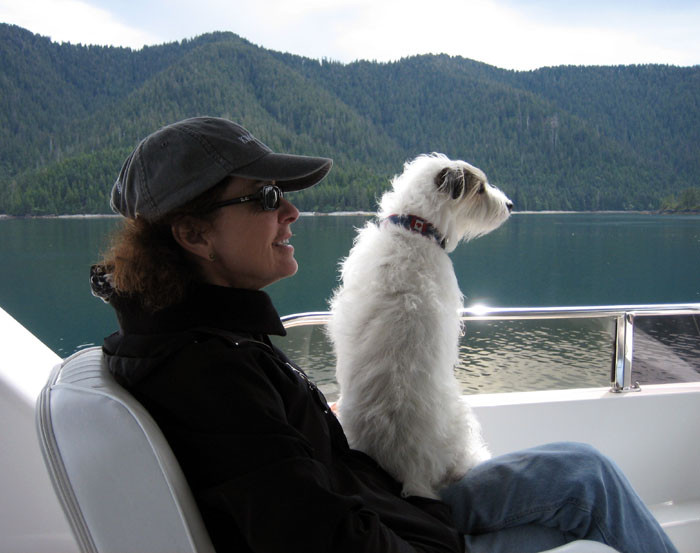
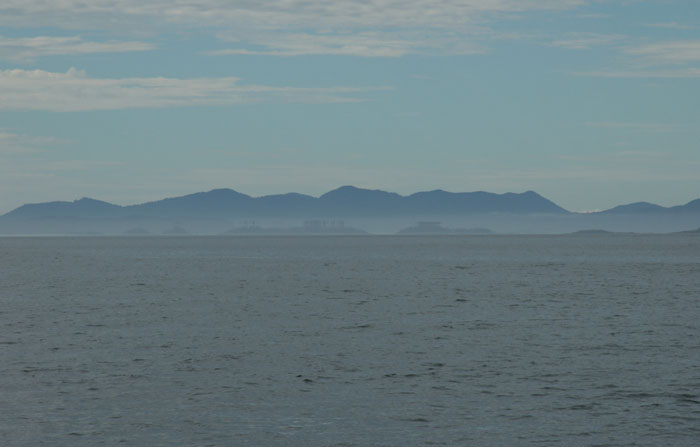 MISTY
ISLANDS
MISTY
ISLANDS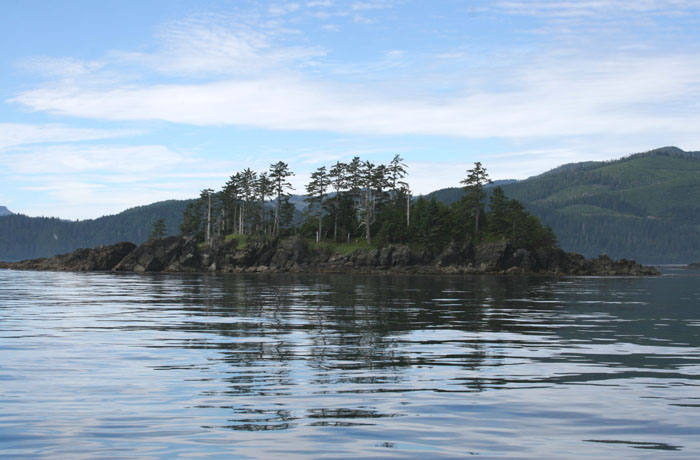 But for the most part, it’s a beautiful landscape, rugged enough to
withstand the storms. They are like a wind swept masterfully created
bonsai, a lovely huge rugged landscape of bonsai, perched on the rocky
crags of the shoreline.
But for the most part, it’s a beautiful landscape, rugged enough to
withstand the storms. They are like a wind swept masterfully created
bonsai, a lovely huge rugged landscape of bonsai, perched on the rocky
crags of the shoreline. 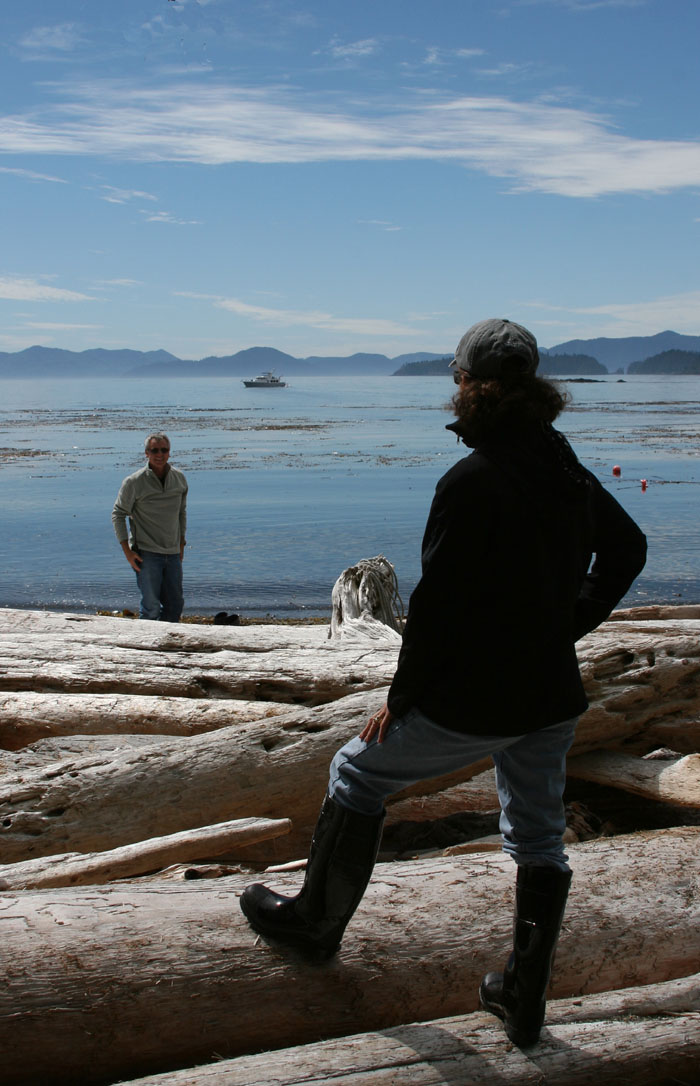
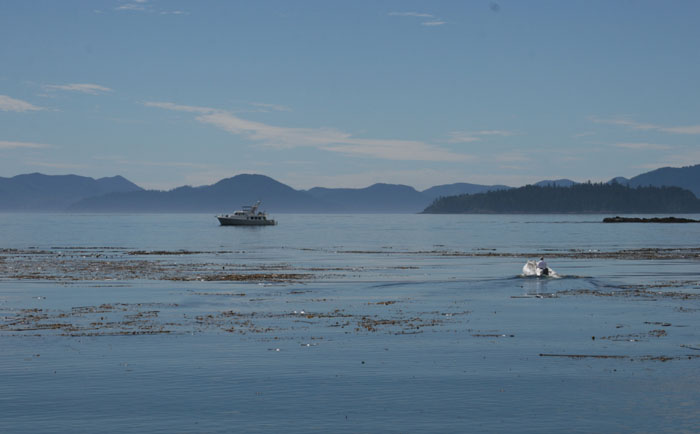
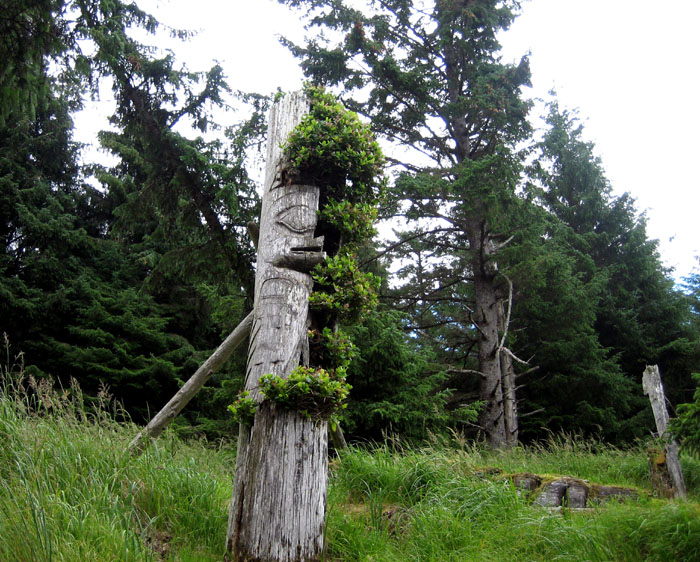 GREETED
BY HUGE DECAYING TOTEMS
GREETED
BY HUGE DECAYING TOTEMS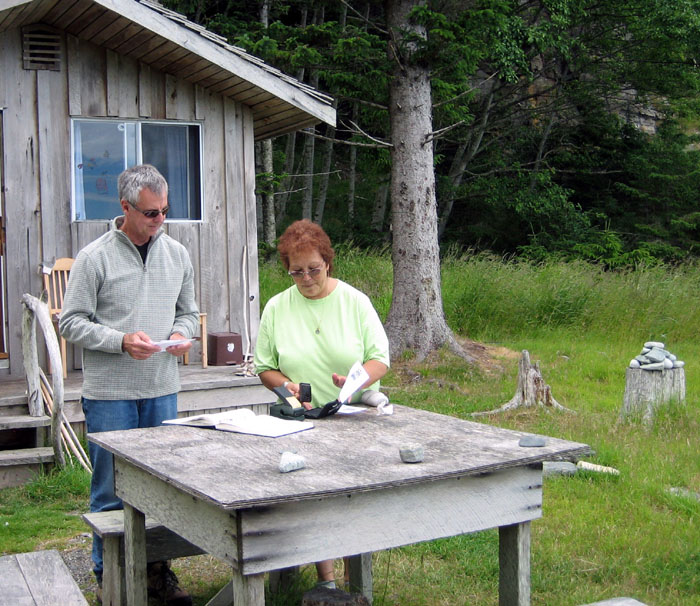
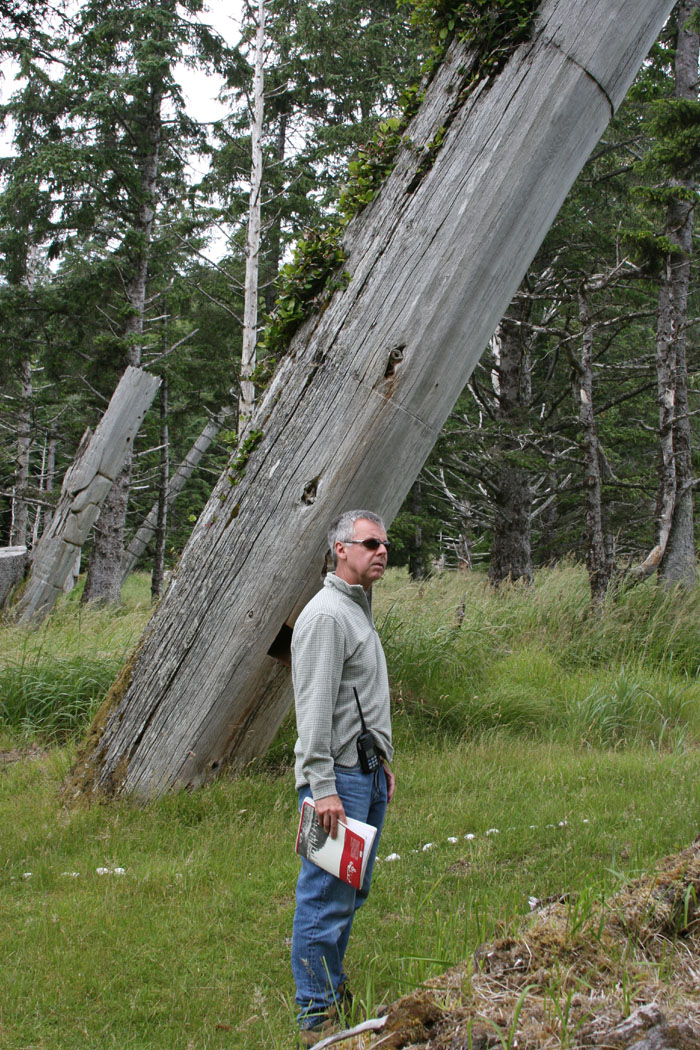 She
brought out some books that showed detailed drawings of what some of the
totems looked like before. They were drawn and explained in detail by
John Smyly in his book, Those Born at Koona, and which also
included actual photographs taken of the village in 1878 by well-known
geologist, George W. Dawson. The book also included information from the
only written record of interviews with a Skedans chief who in the early
1900’s was able to recall all the houses, and poles and many of the
stories behind them, going back thirty years from memory. This
information is really the only detailed record of what the village was
like and the people that lived here. Without these valuable drawings and
photographs and pain staking interviews with this surviving Haida much
more of this fascinating culture would be lost.
She
brought out some books that showed detailed drawings of what some of the
totems looked like before. They were drawn and explained in detail by
John Smyly in his book, Those Born at Koona, and which also
included actual photographs taken of the village in 1878 by well-known
geologist, George W. Dawson. The book also included information from the
only written record of interviews with a Skedans chief who in the early
1900’s was able to recall all the houses, and poles and many of the
stories behind them, going back thirty years from memory. This
information is really the only detailed record of what the village was
like and the people that lived here. Without these valuable drawings and
photographs and pain staking interviews with this surviving Haida much
more of this fascinating culture would be lost. 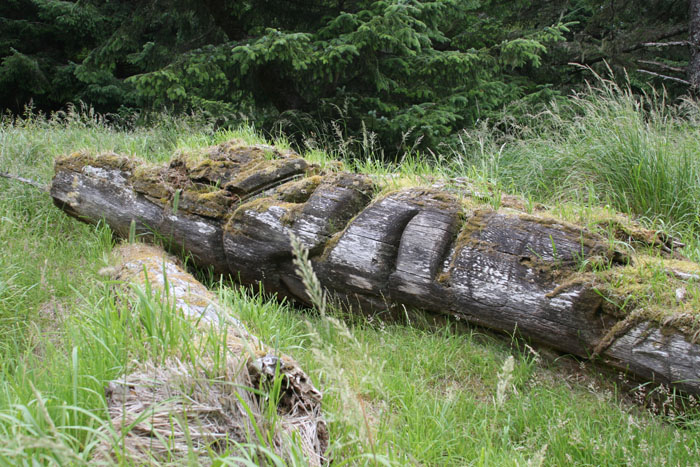 STORY
OF THE TOTEMS
STORY
OF THE TOTEMS
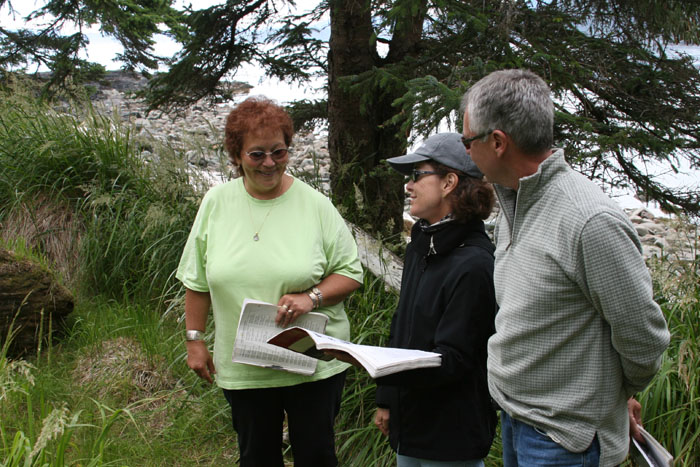 THANKS
TO THE GRASS ROOTS MOVEMENT
THANKS
TO THE GRASS ROOTS MOVEMENT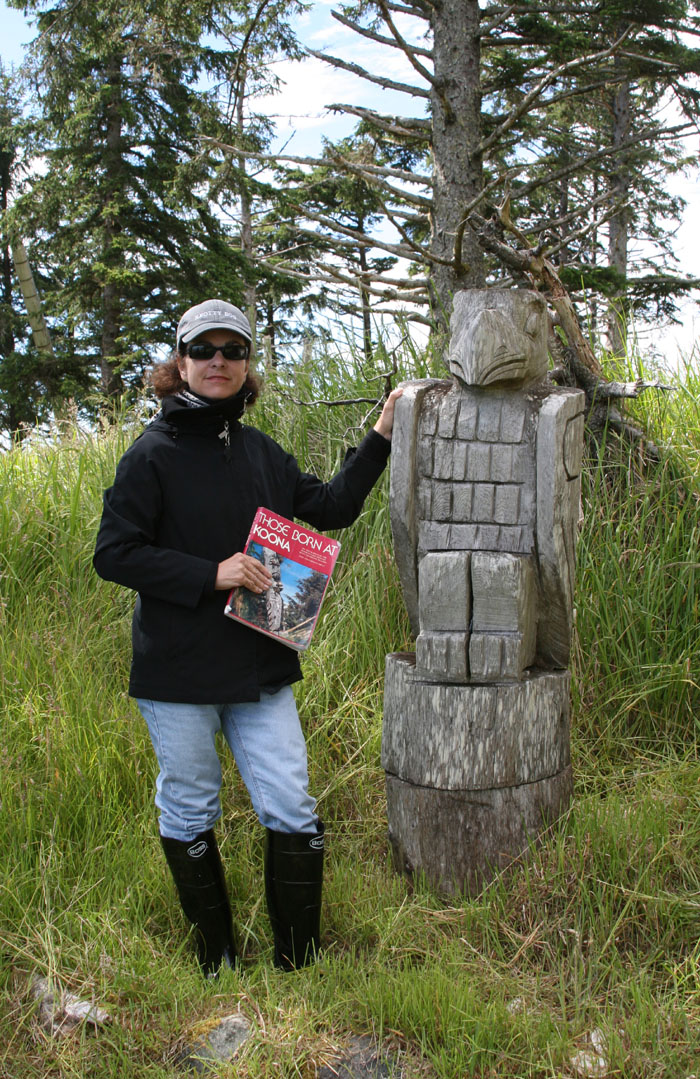 They
seemed to be having some difficulty again and dropped the anchor several
places before they finally got a bite. Once settled, they called the
watchman, Fran, and asked permission to come ashore. Fran told them where
they are is not the anchorage, that it is not a safe place that they
should anchor on the south side but they insisted on remaining where they
were, so Fran finally gave up and simply said “OK”. She said she would
begin our tour rather than wait for them and they could catch up.
They
seemed to be having some difficulty again and dropped the anchor several
places before they finally got a bite. Once settled, they called the
watchman, Fran, and asked permission to come ashore. Fran told them where
they are is not the anchorage, that it is not a safe place that they
should anchor on the south side but they insisted on remaining where they
were, so Fran finally gave up and simply said “OK”. She said she would
begin our tour rather than wait for them and they could catch up.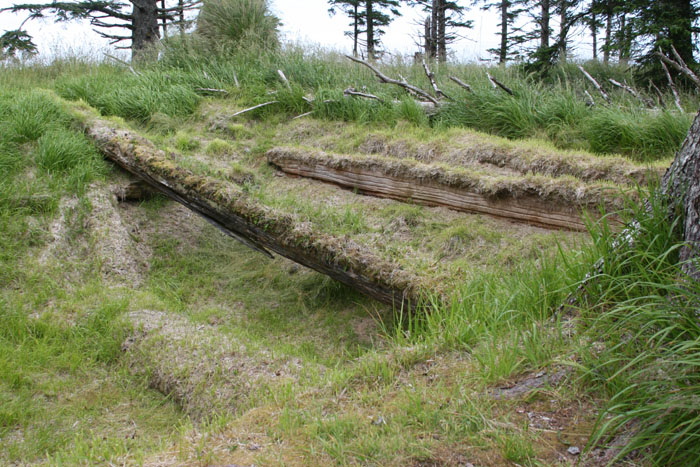 As
the tour continued, Fran pointed out a large square depression in the
landscape, now moss covered and a few remain of the beams and posts of the
most prominent long house left in the village. She explained the
architecture, how it was built, and how it could be disassembled and
carried by canoe to their summer village. She described vividly the
important ceremonies that went on in inside. Each long house and building
had a name and this was called “Clouds Sound Against It (As They Pass
Over). It was huge, probably 50 feet square and stepped down in levels
much like a flattened upside down pyramid.
As
the tour continued, Fran pointed out a large square depression in the
landscape, now moss covered and a few remain of the beams and posts of the
most prominent long house left in the village. She explained the
architecture, how it was built, and how it could be disassembled and
carried by canoe to their summer village. She described vividly the
important ceremonies that went on in inside. Each long house and building
had a name and this was called “Clouds Sound Against It (As They Pass
Over). It was huge, probably 50 feet square and stepped down in levels
much like a flattened upside down pyramid.

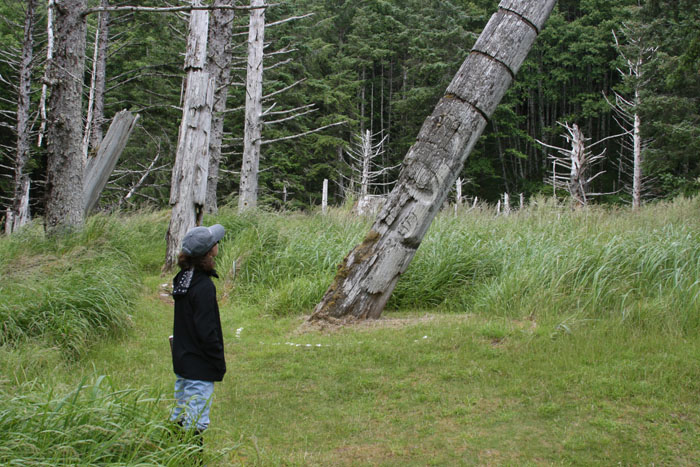 It was a Raven house and the
top most figure on the pole was a Raven, and then just below it was a
human figure stylized as a human. The third figure was the moon which was
only allowed to be used exclusively only by Raven Chiefs. Typically,
when the Raven and moon are shown together it is symbolic of the Haida
legend explaining how the Raven brought light to the world:
It was a Raven house and the
top most figure on the pole was a Raven, and then just below it was a
human figure stylized as a human. The third figure was the moon which was
only allowed to be used exclusively only by Raven Chiefs. Typically,
when the Raven and moon are shown together it is symbolic of the Haida
legend explaining how the Raven brought light to the world: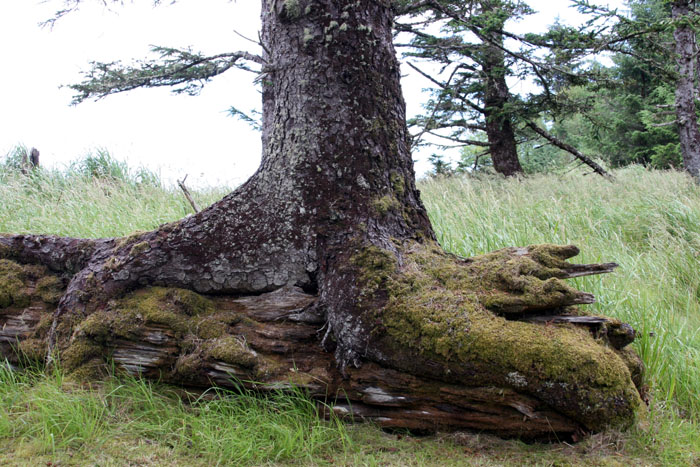 EAGLE’S
GRASP
EAGLE’S
GRASP









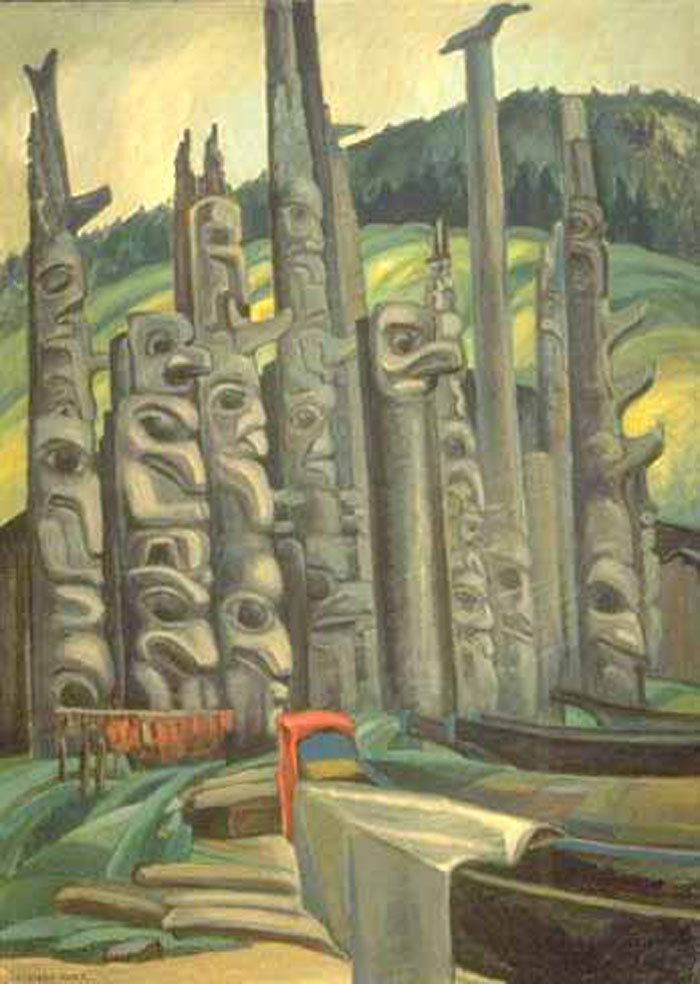 EMILY
CARR
EMILY
CARR